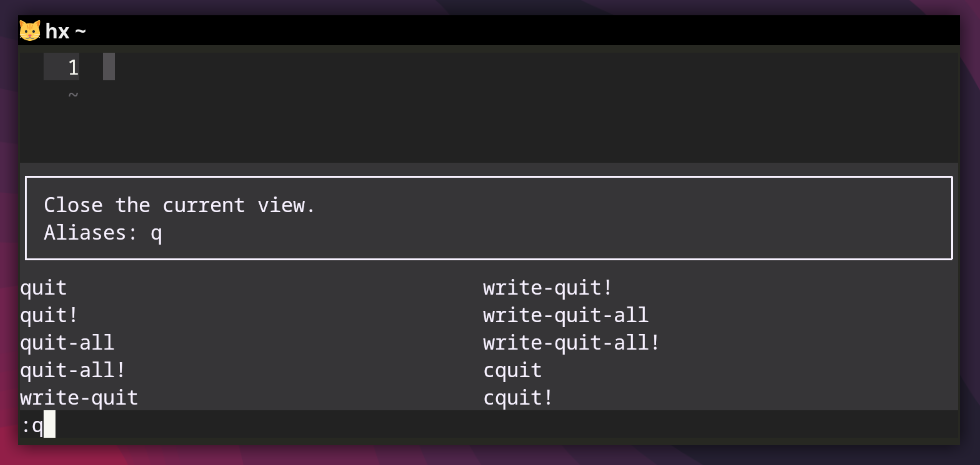I’d describe it as “NeoVim for people who don’t want to spend time configuring it”. It has syntax highlighting (for pretty much any language you can think of) and LSP support out of the box. And the config file is just a TOML file. Here’s my current config for example:
Also using commands after typing the : is easier than in NeoVim since Helix will show you a list of available commands and a description of the closest match (or the one you choose from the list with the tab key). It looks like this:
You can also use Intellij Ultimate, the only big missing features are project config if you have mismatched versions of Gradle/AGP/Kotlin as well as the profiler.
I tried it a few weeks ago and it actually has much less input lag and faster jumps than neovim did, which surprised me a lot.
So now I’m running ideaj again because it’s actually faster than neovim once it’s started… It’s a strange world.
I switched away from Jetbrains editors a few years ago because they felt slow and laggy but I’m impressed now. Also I enjoy using something else than my colleagues who are all on VS code.
Getting a productive setup for Python work is a matter of a few extra lines of TOML. The pre-release version on master also allows for multiple LSPs per language, which means I can combine pyright with ruff.
The modal key chords are verb-object instead of object-verb. It’s not a main selling point to me. However, you get multi-cursors out of the box, which I’ve always found simpler than e.g. macros. In general, keybindings are discoverable. I learn something new every week.
All in all, despite a few rough edges, it’s a nice alternative to needing to get a PhD in neovim configuration to get anywhere remotely near the cool setups other people are rocking.
Helix
I’d describe it as “NeoVim for people who don’t want to spend time configuring it”. It has syntax highlighting (for pretty much any language you can think of) and LSP support out of the box. And the config file is just a TOML file. Here’s my current config for example:
That’s it. No need to deal with Lua or VimScript
Also using commands after typing the
:is easier than in NeoVim since Helix will show you a list of available commands and a description of the closest match (or the one you choose from the list with the tab key). It looks like this:I use Helix for quickly editing files and coding
Same, I switched to helix about a year ago, and do all my coding (except for android because of they don’t make it easy to not use android studio).
I was on vim for decades, but helix is finally the one that’s powerful enough to make me switch.
You can also use Intellij Ultimate, the only big missing features are project config if you have mismatched versions of Gradle/AGP/Kotlin as well as the profiler.
I tried it a few weeks ago and it actually has much less input lag and faster jumps than neovim did, which surprised me a lot.
So now I’m running ideaj again because it’s actually faster than neovim once it’s started… It’s a strange world.
I switched away from Jetbrains editors a few years ago because they felt slow and laggy but I’m impressed now. Also I enjoy using something else than my colleagues who are all on VS code.
Another vote for
hx!Getting a productive setup for Python work is a matter of a few extra lines of TOML. The pre-release version on master also allows for multiple LSPs per language, which means I can combine pyright with ruff.
The modal key chords are verb-object instead of object-verb. It’s not a main selling point to me. However, you get multi-cursors out of the box, which I’ve always found simpler than e.g. macros. In general, keybindings are discoverable. I learn something new every week.
All in all, despite a few rough edges, it’s a nice alternative to needing to get a PhD in neovim configuration to get anywhere remotely near the cool setups other people are rocking.
This does sound cool and catches my interest.
I really like Helix! When the plugin system comes it will be great, because it’s definitely missing some key features